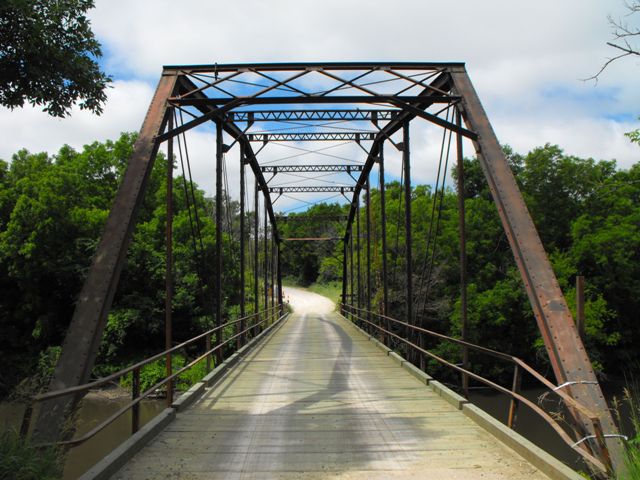We Recommend:
Bach Steel - Experts at historic truss bridge restoration.
BridgeHunter.com Phase 1 is released to the public! - Visit Now
Tremaine Bridge
Bone's Mill Bridge - Bever Bridge (Iowa Number 171920)

Primary Photographer(s): Nathan Holth and Rick McOmber
Bridge Documented: July 1, 2009
Rural: Hamilton County, Iowa: United States
Metal 8 Panel Pin-Connected Camelback Through Truss, Fixed and Approach Spans: Metal Stringer (Multi-Beam), Fixed
1902 By Builder/Contractor: N. M. Stark of Des Moines, Iowa
1940
160.0 Feet (48.8 Meters)
186.0 Feet (56.7 Meters)
14.4 Feet (4.39 Meters)
1 Main Span(s) and 1 Approach Span(s)
171920

View Information About HSR Ratings
Bridge Documentation
View Archived National Bridge Inventory Report - Has Additional Details and Evaluation
This bridge is a rare Iowa example of a pin-connected camelback truss bridge. The Historic Bridge Inventory remarks that "only a handful" were identified. If so, this bridge is very important on a statewide basis and should receive high preservation priority. The bridge contains an eight panel camelback truss main span with a single steel stringer approach span. The approach span has lattice railings which would appear to be original, while the main span has two angles composing the railing system. The truss is traditionally composed: (up-set eyebars, back-to-back channels with v-lacing), although the v-lacing on the vertical members is positioned parallel to the truss line, which is a less common positioning when compared with surviving trusses from this period on a nationwide scale.
There is impact damage to a vertical member, which was subsequently repaired with welded plate steel. A diagonal member has also been replaced at this same area.
Information and Findings From Iowa's Historic Bridge InventoryDiscussion of Bridge The Tremaine Bridge spans the Boone River in Independence Township, south of Webster City. Carrying an unpaved county road, the structure consists of a single pin-connected Camelback through truss, supported by steel cylinder piers. The bridge's construction dates from 1902. In April of that year the Hamilton County Board of Supervisors contracted with Des Moines bridge contractor N.M. Stark to supply and build this 160-foot truss. The proposed new structure, which cost $3,600, would replace an existing bridge over the Boone River at this point, built next to Bone's Mill. Using steel rolled in Pittsburgh by Carnegie, Stark erected the truss on timber falseworks near the Tremaine Post Office, completing the bridge later in 1902. The Tremaine Bridge has carried traffic since, with only maintenance-related alterations to its superstructure. Straight-chorded Pratt through trusses were used extensively throughout Iowa for medium-span crossings in the late 19th and early 20th centuries. For longer crossings after the turn of the century, however, bridge companies could develop greater efficiency with polygonal-chorded Pratt variants, primarily Parker, Pennsylvania and Camelback trusses. With its distinctive five-faceted upper chords, the Camelback configuration was disdained by some engineers (including the redoubtable J.A.L. Waddell, who called it "uncompromisingly ugly") for its tendency under certain conditions to reverse compressive and tensile forces acting on their individual members. As a result, Camelback trusses never received widespread acceptance. Relatively few were ever built on Iowa's roads, and only a handful have been identified as extant by the bridge inventory. The Tremaine Bridge is thus technologically significant as a well-preserved example of this uncommon structural type [adapted from Fraser 1990]. Bridge Considered Historic By Survey: Yes |
![]()
Photo Galleries and Videos: Tremaine Bridge
Bridge Photo-Documentation
Original / Full Size PhotosA collection of overview and detail photos. This gallery offers photos in the highest available resolution and file size in a touch-friendly popup viewer.
Alternatively, Browse Without Using Viewer
![]()
Bridge Photo-Documentation
Mobile Optimized PhotosA collection of overview and detail photos. This gallery features data-friendly, fast-loading photos in a touch-friendly popup viewer.
Alternatively, Browse Without Using Viewer
![]()
Maps and Links: Tremaine Bridge
Coordinates (Latitude, Longitude):
Search For Additional Bridge Listings:
Bridgehunter.com: View listed bridges within 0.5 miles (0.8 kilometers) of this bridge.
Bridgehunter.com: View listed bridges within 10 miles (16 kilometers) of this bridge.
Additional Maps:
Google Streetview (If Available)
GeoHack (Additional Links and Coordinates)
Apple Maps (Via DuckDuckGo Search)
Apple Maps (Apple devices only)
Android: Open Location In Your Map or GPS App
Flickr Gallery (Find Nearby Photos)
Wikimedia Commons (Find Nearby Photos)
Directions Via Sygic For Android
Directions Via Sygic For iOS and Android Dolphin Browser
USGS National Map (United States Only)
Historical USGS Topo Maps (United States Only)
Historic Aerials (United States Only)
CalTopo Maps (United States Only)


